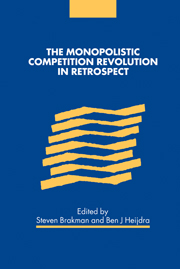Book contents
- Frontmatter
- Contents
- List of contributors
- Preface
- 1 Introduction
- Part I Underground classics
- 2 Monopolistic Competition and the Capital Market
- 3 Monopolistic competition and optimum product diversity (May 1974)
- 4 Monopolistic competition and optimum product diversity (February 1975)
- Part II Current Perspectives
- Part III International trade
- Part IV Economic geography
- Part V Economic growth
- Part VI Macroeconomics
- Index
3 - Monopolistic competition and optimum product diversity (May 1974)
Published online by Cambridge University Press: 22 September 2009
- Frontmatter
- Contents
- List of contributors
- Preface
- 1 Introduction
- Part I Underground classics
- 2 Monopolistic Competition and the Capital Market
- 3 Monopolistic competition and optimum product diversity (May 1974)
- 4 Monopolistic competition and optimum product diversity (February 1975)
- Part II Current Perspectives
- Part III International trade
- Part IV Economic geography
- Part V Economic growth
- Part VI Macroeconomics
- Index
Summary
Introduction
This chapter is an attempt to formalise a simple general equilibrium version of the Chamberlinian monopolistic competition model, in order to test whether there is any validity in the oft-quoted assertion that monopolistic competition leads to too much product diversification. Chamberlin (1950) himself was careful not to make any such assertion; as a matter of fact he saw the central issue very clearly, and expressed it succinctly as follows: ‘It is true that the same total resources … may be made to yield more units of product by being concentrated on fewer firms. The issue might be put as efficiency versus diversity.’ Kaldor (1935), too, saw that excess capacity did not mean excessive diversification. He said that if economies of scale were exploited to a greater extent, ‘the public would be offered finally larger amounts of a smaller number of commodities; and it is impossible to tell how far people prefer quantity to diversity and vice versa.’ What this really means is that a model must be specified in greater detail to determine conditions under which the one or the other might be expected. The one example which has been worked out in some detail, the Hotelling spatial location model, has led many economists to the presumption that there is in fact excessive diversity associated with monopolistic competition. The results of our analysis throw considerable doubt on this presumption.
- Type
- Chapter
- Information
- The Monopolistic Competition Revolution in Retrospect , pp. 70 - 88Publisher: Cambridge University PressPrint publication year: 2001
- 375
- Cited by



